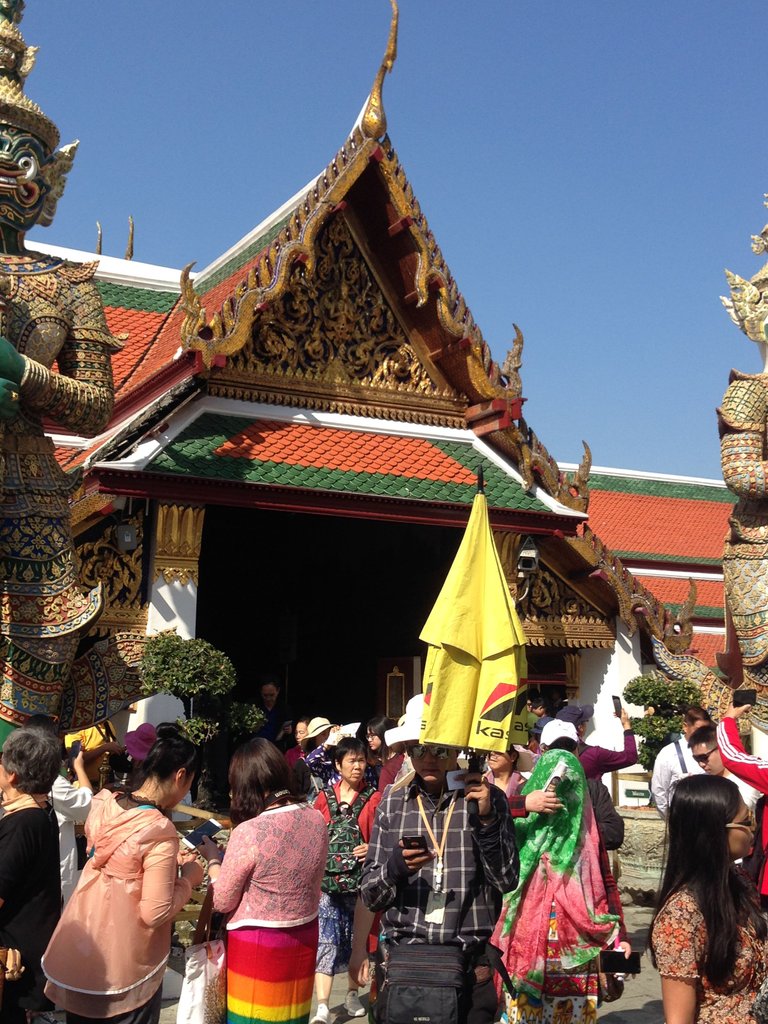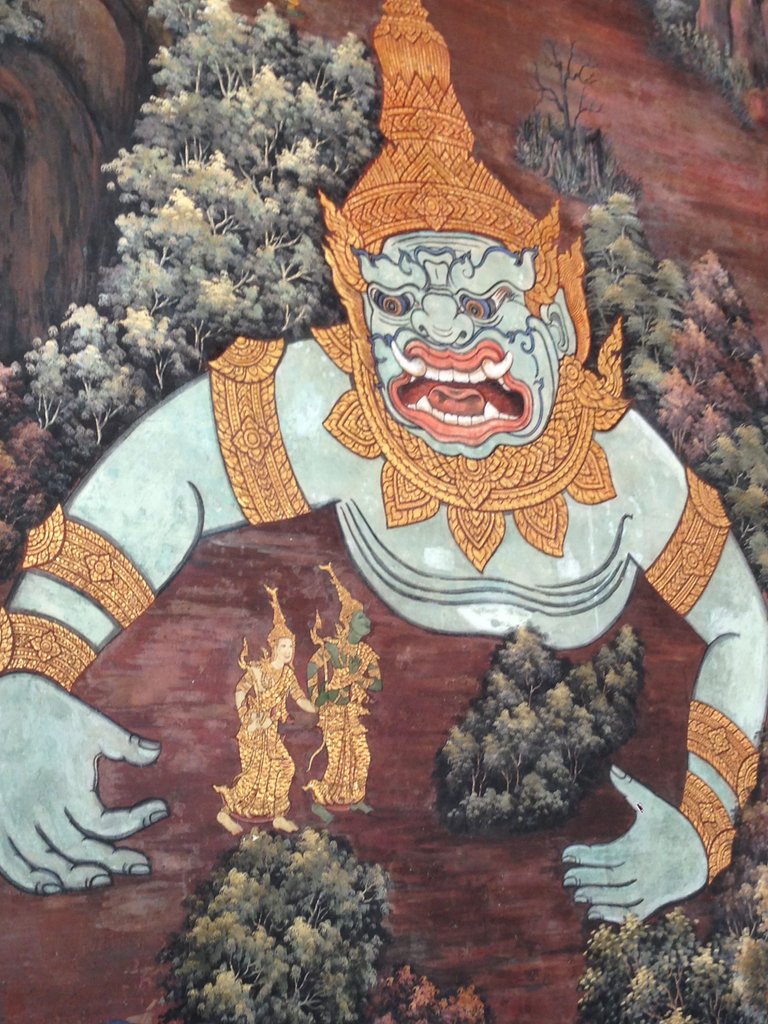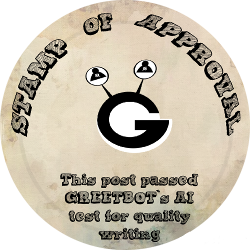Bangkok Journal – The Grand Palace:
Yaowarat Road, Bangkok, Chinatown, Mon, Dec 18, 2017:
We came into Bangkok on the redeye from Busan, South Korea, where my wife and I are teachers at one the international schools. Jeju Air is very reasonably priced, but you definitely get what you pay for – no in-flight meals, movies, etc., and the seats were hard as rocks. We got into Suvarnabhumi Airport at 12:30 (2:30 Korea time) in the dead of night. By the time we got through Immigration, got our bags, passed Customs, found a cab, and got to the hotel, all while in the weird dreamlike state you are in when you stagger around in a strange airport in the dead of night on two hours of sleep, it was 2:30 AM. More staggering. More fumbling – passports, signing in, bags, room keys. The hotels here have gone to electronic keys like plastic credit cards. You even have to swipe the key to get to your own particular floor.
At last we got to bed and slept like rocks. For me the chief challenges of Bangkok are a) dealing with the heady cocktail of noise, crowding, and pollution that make up the pace of everyday life here, and b) navigating this city’s snarled transport system. So Laurie, my wife, and I have concluded that the best way to hit Bangkok is to pick one central location convenient to what you want to see, and go from there. Laurie had already been around some of the tourist hot spots, so the decision on what we were to see in our two odd days in Bangkok fell to me. I opted for
- The Grand Palace
- Chinatown
- The Jim Thompson House
I would have mad Wat Pho #4, but we had been there some last year on our way out to Korea from Egypt. Anyway, we decided our best move was to find a place in Chinatown. That would put us a short tuk-tuk ride from the Grand Palace, and we could enjoy the delicious Chinese food we have fallen in love with. We were also a reasonable walk from the train station, and the brand new Bangkok metro system.
We got out the next day to take care of that new essential task of travelers – getting a new sim card for our phones. Essentially your sim card is your phone’s soul. So now I had a new undead phone that works only in Thailand, but it allows essential communications in a big, strange city. We also had to switch rooms, as the initial room they gave us had twin beds. And then we needed sunglasses for Laurie. All legit business, but it ate up the morning. By the time we got to the Grand Palace, our first objective for the day, it was hot, with the mid-day sun glaring down on us, and mobs of people descending on the place like the second coming of Jim Morrison. Bangkok is big, with 8 million people, 14 million if you count the whole metro area. One Thai in eight lives in Bangkok or its environs, and it seemed like every one of them was up and on the road that day.
Bangkok is a fascinating city. Just walking down Yaowarat Road in Chinatown is an experience worthy of its own missive. [See upcoming Journal] It is a complete sensory overload. But I also find it overwhelming. The noise, the crowds, the pollution are indescribable. A little background is in order. Bangkok is on the Chao Phraya river, which flows down from the hills of northern Thailand, and winds through a sea of green rice paddies like a Louisiana bayou. Back around the time Henry VIII was beheading his wives, a Thai monarch had a canal built to cut through one of the long loops of the river. This made the site an important point and a meeting ground. Then in the 1760s the Burmese came in and trashed Ayutthaya, the ancient Thai capital some 40 miles upriver. So, in 1782 Rama I, the new Thai king, established his capital on the right (western) bank along the new curve of the river as it flowed south. Its official name is: Krungthepmahanakhon Amonrattanakosin Mahintharayutthaya Mahadilokphop Noppharatrat-chathaniburirom Udomratchaniwetmahasathan Amonphimanawatansathit Sakkathattiyawit-sanukamprasit, which means “City of Angels, Great City of Immortals, Magnificent City of the Nine Gems, Seat of the King, City of Royal Palaces, Home of Gods Incarnate, Erected by Vishvakarman at Indra's Behest”. But the locals just kept calling it by its original name: Bangkok, The Island Village.
The best way to visualize the heart of Bangkok is to draw a big ‘C’ on your page and then have lines radiating out from the ends. The Grand Palace of the Thai monarchs is set in that C. Now stick a little rectangle on top of the line running from the bottom end of the C and you have Chinatown. As the city grew they kept adding little canals linking the two lines radiating out from the ends of the C. We are two canals out from the palace (about a mile and a half).
When we finally got out to the Grand Palace it was the heat of midday, which here, even in December, is respectable. And there was a gigantic mob at the gate. Tours were converging on the place, long lines of tourists surging forward, following their Thai guides holding umbrellas and shouting instructions. Everyone swarmed on the main gate, which only allows two in at a time, so we had a crush of people of Cairo-esque proportions. Then to make things worse, once we were inside I realized I had foolishly walked out of the hotel with shorts on! They were long, and covered my knees, but shorts they were, and so when we got inside the Grand Palace I was told by the guards I had to go out and buy long pants in the line of shops across the road. I rented a pair of garish purple Bali pants for 50 baht (about $1.50) with a deposit. When I got back in, Laurie had found out that we only had a couple hours inside before we would have to leave, so she suggested we abort mission and go back in the morning. I reluctantly agreed, but I think her idea was correct. She did get a shot of me in the purple pants before I returned them though!
Yaowarat Road, Bangkok, Chinatown, Tuesday, December 19, 2017:
Today we set out for the Grand Palace bright and early, to try to beat the crowds and the midday heat. Following the advice of the hotel desk clerk, we avoided the noisy, motorized tuk-tuks and made our way down to the river to catch the water taxi. The ferries on the Chao Phraya are fast and efficient, but very crowded. You board it like a bus, out on a little jetty, and hustle your way to the middle of the boat where there is space. The Chao Phraya is a major north-south route running through the city, and river traffic is heavy. They even have different color ferry routes, to take people ahead to the stop they need. We boarded with a bunch of monks in saffron robes, as well as assorted European backpackers, Chinese tourists, and ordinary working Thais. With the wait, it wasn’t as fast as a tuk-tuk, but it was much cheaper – 15 baht apiece – about 45 cents. Plus – how often do you get to go Venetian like that?
The security around the Grand Palace has been tightened noticeably since last year. The main road closest to the palace has been sealed off to most traffic, and entry to the restricted area outside the walls is limited to two closely monitored checkpoints. The one we passed yesterday had us hold our passports up to a camera before going in. The checkpoint by the ferry landing did not bother with this. This implies that a lot of the new security measures are cosmetic. Still, we also found it much harder to get sim cards for our phones this time. There have been angry protests here over the economy, and the government has grown increasingly wary. It does bring to mind just how much the area around the palace is still the center of power in this country. We passed the Ministry of Defense on the way in yesterday, kitty-corner to the Thai Supreme Court, and the Interior Ministry is just a block away.
We did beat the worst of the crowds, but it was still a project getting in. Only a portion of the palace grounds are open to the public. Rather than one palace, it is a series of separate buildings and compounds, all surrounded by a great stone wall. The most picturesque part is the northeast corner, where lies the pavilion housing the Temple of the Emerald Buddha. Entering here is truly breathtaking, and I speak as one who has seen the Vatican, and the Blue Mosque in Istanbul! This place is an explosion of color from the moment you enter, with gleaming, golden spires, soaring towers, gilded guardian demons, and stately gardens. Unfortunately, you also have Vatican-level mobs of tourists with no checks on who brings in tours and when. And people cannot resist taking pictures, though, truth be told, I can’t blame them, I went wild too. The place is visually stunning beyond words.
Thailand is a mélange of cultures – Hindu, Buddhist, Confucian, and with a vibe that is uniquely their own. The sheer number of shrines and temples within the Grand Palace is stunning. I think each generation of monarchs has added to the splendor here. The great former residence of the kings (They moved to the suburbs in the 1930s.) is done in pompous 19th century Western style. After seeing the traditional architecture, it looks rather whitewashed and dull, although it is enlivened with some Thai architectural flare at the top. In other words, the Western aspect here is simply one more layer of plaster on a very old structure.
For me the thing that absolutely wowed me was the great mural depicting the Ramayana. The pavilion around the Temple of the Emerald Buddha is rectangular shaped, and if you start inside the north gate and immediately turn right, you can follow the story as you go clockwise along the inside wall. It is the great epic of India, their version of the Iliad and the Odyssey, or the Game of Thrones series. It tells the tale of Rama, the legendary prince of Kosala, his beloved wife Sita, and his epic quest against Ravana, the demon king. In it you have gods, demons, magic, a monkey army, and a cast of thousands. The art goes back to the days of King Rama I of Thailand, the founder of the current dynasty, and of Bangkok, and has been lovingly tended and repaired ever since.
For me, it finally gave me a sense of what Thai art is about, and a window into the souls of the people here. The first thing you notice is that you don’t have the Western-style single perspective. For years I was told that was because those poor Asian artists lagged behind the more advanced West. Bull! The artists who designed this work knew exactly what they were doing. For them, having one perspective would be boring. No, you have many perspectives, many intersecting viewpoints coming together that you can briefly glimpse as a whole. The story jumps back and forth, across time and space. And even within one scene you have numerous vignettes – a god opening a door in the sky, battles between armies, women playing a game like Chinese checkers, monkey youths playing soccer, all part of a greater whole that only the gods can see. And here and there we see portraits – a plump prostitute worthy of Robert Crumb, a bored merchant staring out the window, couples making love, all moving through a verdant landscape of forests and rolling hills. And we the Thai everyman – mankind, going about our petty dealings, and only seeing a tiny glimpse of the gods-eye view. But each of us has a part of the great tale of the world. I joked about comparing it to George R.R. Martin’s Game of Thrones series, and that is only partly a jest. Martin’s books have the same feel – jumping back and forth across time and space, showing you castles and hovels, tyrants and fools, magic and squalor, all a part of a greater song.
The Temple of the Emerald Buddha was for me something of a let-down. It’s not an emerald, but a carved piece of green jadeite. That said, it is a treasure beyond price to the Thai people. The image dates back to Lanna, the first Thai kingdom, in the northern hill country around Chiang Mai. It is said to be a palladium, a sacred holder of the life of the Thai nation. Three times a year the king of Thailand himself lovingly dresses the image, to mark the traditional seasons: Summer, Rainy, and Winter. The temple itself is truly magnificent but it was jammed with throngs of jostling tourists. I did find a way to get some peace for a moment and attune myself. There are two doorways, an entrance and an exit. Equidistant between them at the back of the temple is a collection box for the maintenance of the building. If you stand right in front of the collection box facing the altar the streams of tourists flow past you like water flowing around a rock in a rushing river. I was able to take a minute, breathe, look at the place, and feel its energy. It is powerful, and alive. But the old school Protestant in me couldn’t help feeling that this is where religions go to die – in great halls of marble and lacquered wood, with gold inlay and clouds of incense. Now, mind you, I will reserve judgement here, because I did not have someone to explain the deeper meaning of the place. Imagine visiting St. Patrick’s Cathedral in New York with only a surface knowledge of Christianity. But this was the vibe I got. Walking out, I thought – Well, I know what set the prophet Muhammad off, taking a hammer to all those gilded statues! Still, The Temple of the Emerald Buddha is a place of genuine beauty and stunning craftsmanship, and was obviously built with love.
Water taxi ferry on the Chao Phraya, down river from the Grand Palace. Very inexpensive to ride.
![IMG_5893.JPG]
Spirit guardian watching the gates to the pavilion.
(
Looking toward the entrance into the pavilion.
Some idea of the mob of people.
Scenes from the Ramayana murals along the inner wall of the Pavilion.
Side view of the great hall housing the Emerald Buddha.
Outside the Pavilion of the Emerald Buddha. Looking toward the Chakri Maha Prasat: "The Great Palace of the Chakri Dynasty". Up until 1932 this was the royal residence. They still have ceremonial Palace Guards on the grounds.










AI to look for newbies who write good content!
 Hi. I am @greetbot - a bot that uses
Hi. I am @greetbot - a bot that uses
Your post was approved by me. As reward it will be resteemed by a resteeming service.
OK, thanks, Bot! :-) I hope to add to the Journal very soon. :-)
Glad to be coming aboard here at Steemit. here is my first blog post: https://steemit.com/travel/@numerian01/bangkok-journal-the-grand-palace